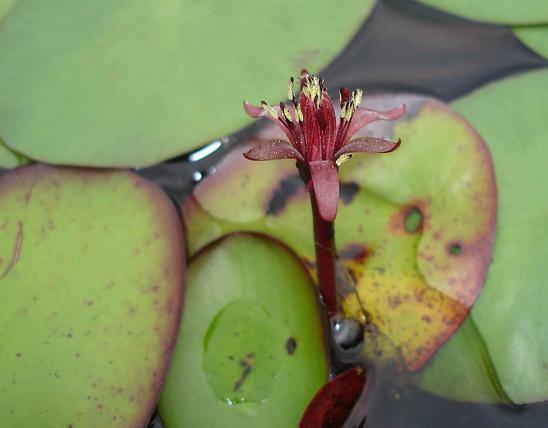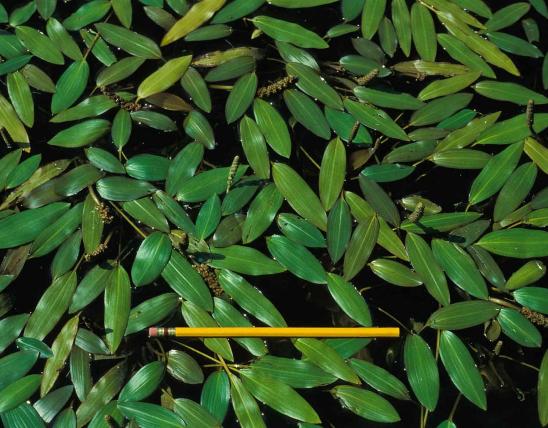
Spatterdock is a perennial, herbaceous, emergent aquatic plant. Flowers at or just above water surface, deep yellow, saucer- or globe-shaped, to 3 inches across; sepals usually 6, overlapping and much larger than the many petals, which are small, thick, oblong, and scalelike, in a ring just below the stamens. The many stamens surround a large, compound ovary. Blooms May–October. Leaves at or just above water surface, egg- to heart-shaped with a wide, basal V-notch, of variable size.
Botanists used to consider our spatterdock the same species as one found in Eurasia (N. lutea), but DNA testing has shown they are not so closely related. That’s why our species is now called N. advena. There are two subspecies in Missouri: ssp. advena, with green or yellowish sepals and flowers ¾ to 2 inches wide, and ssp. ozarkana, with reddish- or purplish-tinged sepals and flowers ½ to 1 inch wide. Subspecies ozarkana is more common in Missouri; it is often seen in spring-fed Ozark streams and rivers.
Similar species: Water lilies (Nymphaea spp.) have large, showy flowers with many petals that are typically white to pink to violet; the leaves are round, with a cleft. American lotus (Nelumbo lutea) has yellow to cream-colored flowers that open to 8 inches across with a large central disk that resembles a showerhead. The leaves do not have a cleft and are usually held above the water.
Leaf length and width: 2–16 inches.

Scattered along and south of Missouri River.
Habitat and Conservation
Margins of ponds, lakes, slow-moving to stagnant portions of streams, rivers, and spring branches, sloughs, and fens.
Status
Native Missouri aquatic plant. For comments on taxonomic (name) changes and subspecies that are present in Missouri, see Description above.
Human Connections
The starchy roots were eaten by Native Americans, as were the seeds.
Ecosystem Connections
Pollinators include bees, flies, and beetles. Interestingly, when the flowers close in the evening, they sometimes trap beetles in the flower overnight, releasing them when they reopen the next morning. The seeds are consumed by deer, muskrat, beaver, raccoons, and waterfowl.




































